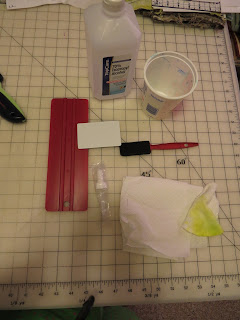The Sharpie markers contain permanent ink, which will not wash away with water. Permanent ink is hydrophobic, meaning it is not soluble in water. However, the molecules of ink are soluble in another solvent called rubbing alcohol. This solvent carries the different colors of ink with it as it spreads in a circular pattern from the center of the shirt. (according to stevespanglerscience.com)
So the first thing I tried, years ago, was tie dying. There are a few sites that show different ways to do this, and I don't remember the exact one I used. They're all similar, but I love the monster t-shirt at the bottom of this one!
 |
| I colored this one first |
 |
| above piece wrapped on a dowel with alcohol applied |
 |
| Wrapped on the dowel first, then colored, with alcohol applied |
 |
| The one I colored first |
 |
| The one colored after wrapping |
More recently, Quilter's Newsletter had an article on doing image transfer. Please note: This link does NOT have the instructions, but is a link to the issue.
We did this activity at the ArtCGirlz meeting in March.
I've been having fun with that one, finding ways to use it. Here's how, if you want to try it yourself. Good images can be found by doing a google search for coloring pages. Just remember, simple is better.
NOTE- the colors are not as bright as the original, as you can see here. Also, directional images will be reversed.

You will need:
8 1/2" x 11" white card stock
Assorted Sharpie markers
11" x 14" piece of clean muslin
10" x 12" piece of white cotton
scotch tape
rubbing alcohol
dropper or sponge paintbrush
credit card or flat rubbing tool
iron
I also keep a paper towel, scrap fabric nearby to blot excess alcohol

Step 1: Color your selected image well. Go over it a couple of times to really saturate the paper with ink. (Make sure to protect your work surface with a piece of scrap paper)
The lower half of this picture is the reverse, so you can see the ink has soaked through in spots.
Step 2: Lay the 11" x 14" muslin piece on your work surface. Lay the 10 ' x 12" piece of white cotton on top of it. (Both fabrics should be crease free)
Place your colored image face down on top of the white cotton. Tape in place to prevent shifting.
Step 3: Use the dropper or brush ( I prefer the brush) to spread the alcohol over the surface of the paper. You need enough to soak through, but not a puddle.
Step 4: Use your credit card or rubbing tool to push the ink into the fabric. Press firmly and make sure you go over the entire image. I go over it once vertically and once horizontally.
If the alcohol starts to make a puddle, use the paper towel to soak it up. Try not to let it go over the edge of the paper!
Step 5: Lift one or more corners of the paper to see if the image had transferred successfully.
(You can see here some of the alcohol escaped and there is ink past the image)
If it has not, add a bit more alcohol and rub the back again.
Step 6: Once the transferred image is dry, press with a hot dry iron to set the image. Remember to put your muslin under the image when you iron it to protect your ironing board.
This process is limited to size by the size of the card stock. As you can see, I tiled the image to make it larger.
You may also notice that some colors transfer better than others. Red always looks pink
So, what to we do with these transfers?? Here are a couple of finished projects I have made using the images I transferred.
Then Mary Lee found this site, showing how to design your own fabric. I used this technique to create a t-shirt.

I had better results using a dropper than a paintbrush, as you can see in this picture. The design on the right was done with the dropper. Also, some of the greens don't seem to spread as nicely as the others.
And similar to that technique is this one, using cups and rubber bands.
 |
| lines and dots- don't worry if the ink bleeds a little |
 |
| After dropping alcohol |
 |
| After drying and pressing |
 |
| Add more designs for a really funky fabric! |
So I've been a bit like a mad scientist in the lab, playing with these. (Here's my lab)
No matter which one you try, it's fun and will give you some unique fabric to use in your projects.
A word about colorfastness- all I have read says that once you heat set it, it is permanent and will not bleed. However, please use caution when laundering these items!! I do know that after repeated washing, it will probably fade.










Playing with colour is so relaxing... like Calgon without the bubbles.
ReplyDeleteCool technique! Sorry I missed the demo at the guild.
ReplyDelete